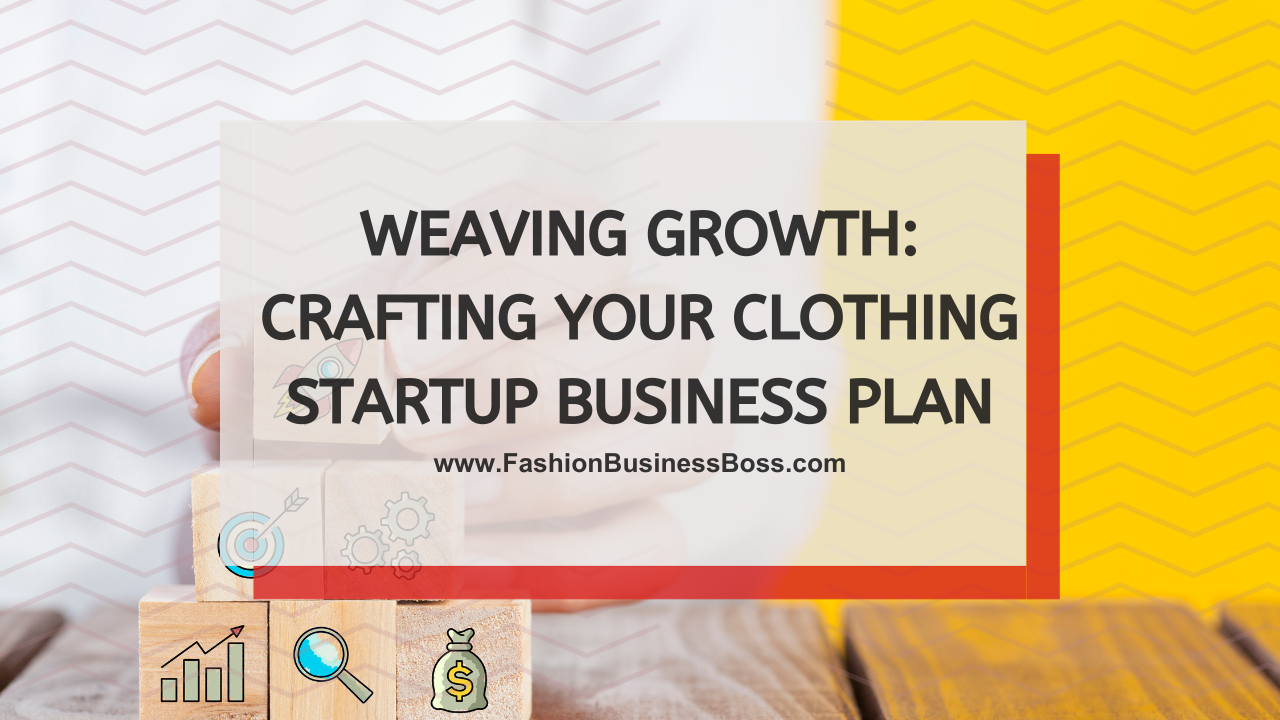Are you passionate about fashion and dream of launching your own clothing startup? The road to growth begins with a well-crafted business plan.
To thrive in the fashion world, a solid clothing startup business plan is your foundation. It’s not just about style; it’s about strategy, market research, and financial projections. Craft it meticulously for a fashionable future.
In this article, we’ll guide you through the essential steps to create a business plan that not only showcases your creativity but also ensures your venture’s viability in the competitive fashion industry.
Setting the Stage
Before we dive into the details, let’s briefly understand why a business plan is crucial for your clothing startup. It’s your roadmap to growth, providing clarity on your goals, target audience, strategies, and financial projections.
Executive Summary: The Elevator Pitch

The executive summary holds immense importance as it serves as the initial introduction to your clothing startup. Its primary purpose is to swiftly capture the reader’s interest. In simple terms, this section should provide a clear and engaging snapshot of your business.
Begin with your mission statement, which is essentially a statement that describes your startup’s core purpose and values. Next, provide a brief yet informative description of your brand, highlighting what makes it distinct. This could include aspects like the type of clothing you offer, your target audience, and your style.
One key element to incorporate is your Unique Selling Proposition (USP). This is what sets your clothing startup apart from competitors. It could be your commitment to sustainable materials, unique designs, affordable pricing, or any other factor that makes your brand special.
Remember, the executive summary is your chance to make a strong first impression. Keep it concise and engaging, ensuring that anyone who reads it quickly grasps what your clothing startup is all about.
Read more about: The Key to Retail: How to Get a Clothes Selling License?
Market Research: Know Your Niche
Comprehending your target audience is a crucial step in building a solid foundation for your clothing startup. To do this effectively, you must pinpoint your specialized area within the vast fashion landscape.
Begin by defining your ideal customers. Who are the individuals most likely to be interested in what your clothing startup offers? Understand their preferences, behavior, and financial capabilities. This information helps tailor your offerings to suit their needs.
To uncover your niche, conduct a thorough analysis of your competitors. Look for opportunities or underserved areas in the market where your startup can thrive. These gaps can be in terms of style, price, quality, or any other aspect that hasn’t been adequately addressed.
Market research isn’t about luck; it’s about knowledge and strategy. The more you understand your audience and identify your unique place in the fashion world, the better equipped you’ll be to build a clothing startup that resonates with your target market.
Brand Identity: Defining Your Style
In the world of clothing startups, crafting a recognizable and lasting brand identity is paramount. Your clothing startup’s brand identity should be distinctive and memorable, leaving a lasting impression in the minds of your audience. Begin by defining your brand’s style and aesthetic, outlining what sets you apart in the fashion landscape.
Consider factors like logo design, color schemes, and typography, ensuring that these visual elements consistently reflect your brand’s personality and style. Equally important is the alignment of your brand’s values with both your mission and the values of your target customers.
Are you all about sustainability, affordability, or luxury? Your values should resonate with your audience. Your brand messaging should be clear, authentic, and connect with your target audience, effectively conveying what your brand represents. In essence, your brand identity goes beyond appearances; it’s about expressing who you are and what you stand for, making it the face of your clothing startup that leaves a lasting impression on your customers.
Product Line: Quality and Variety

In the realm of clothing startups, it’s essential to outline your range of clothing collections. This means specifying the types of clothing you will provide to your customers. It’s not just about what you offer; it’s also about the quality and diversity you bring to the table.
When it comes to quality, highlight the materials you’ll use and the craftsmanship that will go into creating each garment. Discuss the durability, comfort, and overall excellence of your products. This reassures your customers that they’re investing in clothing that will last.
Moreover, your product line should align with the needs and desires of your target market. Explain how your clothing collections cater to their preferences. Is it about trendy fashion, timeless classics, or specialized designs? By demonstrating that you understand and meet your customers’ expectations, you create a strong connection between your brand and your audience.
Your product line isn’t just a list of items; it’s a reflection of your brand’s commitment to delivering quality and variety that resonates with your target market. This aspect is crucial for building trust and loyalty among your customers.
Read more about: The License You Need: Selling Name Brand Clothing
Marketing Strategy: Spreading the Word
Attracting customers to your clothing startup is a pivotal aspect of your business plan. Your marketing strategy serves as the roadmap for how you’ll achieve this goal. It involves a blend of various tactics to ensure a wide reach and effective engagement.
Digital marketing, which includes online advertising and promotions, will be a key component. This entails using platforms like search engines, websites, and email marketing to connect with potential customers in the digital realm.
Social media plays a significant role in modern marketing. Utilizing platforms like Facebook, Instagram, and Twitter allows you to engage with your target audience directly. Posting engaging content and interacting with followers can be a powerful tool.
Consider influencer partnerships, where individuals with a substantial following in the fashion niche promote your brand. Their endorsement can significantly boost your reach and credibility.
Traditional advertising methods, such as print ads or commercials, should not be overlooked. They can still be effective, especially in reaching an older demographic.
Operations and Logistics: Behind the Scenes
The operational and logistical side of your clothing startup is like the backstage crew that makes the show possible. It encompasses several critical aspects that ensure your business runs smoothly and efficiently.
Begin by detailing your material sourcing process. This includes where you will obtain the fabrics and materials needed for your clothing. Clarity in this area helps you maintain quality and consistency in your products.
Inventory management is essential. Describe how you’ll keep track of what’s in stock, how you’ll reorder when necessary, and how you’ll minimize excess or shortages.
Explain your production process. This involves the steps from design to the finished product. If you have partnerships with manufacturers, outline these relationships and their roles in your supply chain.
Warehousing is another critical element. Specify where you’ll store your clothing before it reaches your customers. This affects the efficiency of order fulfillment and timely deliveries.
Address the shipping process, including your chosen carriers and shipping methods. Ensuring reliable and cost-effective shipping is crucial for customer satisfaction.
Lastly, quality control measures should be discussed. Explain how you’ll maintain the quality of your products, addressing any issues that may arise.
Financial Projections: Crunching the Numbers

The financial projections section of your business plan is vital, especially when seeking support from investors or lenders. It offers a clear view of your clothing startup’s financial health and future potential.
Begin by crafting detailed income statements. These provide a snapshot of your expected revenues and expenses over a specific period, usually a year or more. They help gauge your startup’s stability.
Cash flow forecasts are equally important. They predict how cash will flow in and out of your business. This is crucial for ensuring you have enough liquidity to cover expenses and grow.
Include a break-even analysis, which reveals the point at which your startup covers all costs and begins to make a profit. It’s a key metric to understand when your business will become self-sustaining.
It’s essential to be realistic and conservative in your estimates. Overly optimistic projections can erode trust with potential investors. Instead, base your projections on solid research and industry benchmarks.
Read more about: The Path to Prosperity: Strategies for Clothing Entrepreneurs
Funding Requirements: Securing Capital
In the journey of establishing your clothing startup, securing adequate capital is often a critical step. If you find yourself in need of financial support, it’s essential to outline your funding requirements clearly in your business plan.
Begin by specifying the exact amount of capital you require. Be precise about how much money you need to start and sustain your clothing business. This amount should align with your business’s specific needs and financial projections.
Consider various funding options available to you. This may include loans from financial institutions, seeking grants from organizations, or attracting investors who believe in your business idea. Each option comes with its own terms and conditions, so it’s crucial to choose the one that suits your startup best.
When presenting your funding requirements, provide a transparent and detailed plan of how you intend to use the capital. This should include allocations for materials, production, marketing, operational expenses, and any other relevant areas.
Moreover, it’s essential to clearly outline the potential return on investment for your backers. Explain how their financial support will contribute to the growth and stability of your clothing startup.
Team: Building Your Dream Team
Building the right team for your clothing startup is akin to assembling the perfect puzzle pieces. Each member brings a unique set of skills and experience that contributes to the overall strength of your venture. In this section of your business plan, introduce the key individuals who form the backbone of your team.
Start by providing a brief introduction to each team member, focusing on their relevant skills and experience. Whether it’s designers who bring creative flair to your clothing line, marketers skilled in reaching your target audience, or operations experts adept at managing the logistics, shed light on how their expertise aligns with your clothing startup’s goals.
Highlight their qualifications and prior work experiences that make them valuable assets to your venture. Their background and capabilities should clearly demonstrate their ability to contribute to your startup’s growth and efficiency.
The team section of your business plan serves as an introduction to the people who will help bring your clothing startup to life. It emphasizes the skills and experience that make them essential to your business’s operations, reinforcing the notion that your team is well-equipped to navigate the challenges and opportunities of the fashion industry.
Milestones and Timeline: Setting Goals

In your clothing startup’s journey, setting clear milestones and creating a timeline is akin to drawing a map for your adventure. It offers a structured plan that outlines the significant checkpoints, both short-term and long-term, on your path to achieving your goals.
Start by identifying key milestones. These are specific achievements that mark your progress. For instance, launching your online store, reaching a certain number of customers, or expanding your product line can be considered milestones.
Once you’ve identified these milestones, create a timeline that specifies when you aim to reach each one. Be realistic in your timeline, considering the resources and capabilities available to your startup. Short-term milestones may be achieved within months, while long-term ones might take several years.
Having this timeline serves multiple purposes. It provides a sense of direction for your team, ensuring everyone understands the goals ahead. It also acts as a tool for measuring your progress. If you find you’re falling behind or exceeding expectations, you can adjust your strategies accordingly.
Read more about: he Price Tag of Fashion: Clothing Brand Startup Costs
Conclusion
Crafting a comprehensive business plan is the first stylish step towards realizing your clothing startup dream. It not only serves as a roadmap for your journey but also a compelling pitch to potential investors or partners. Remember, the fashion industry is dynamic, so stay adaptable and open to changes as you embark on this exciting adventure.
Frequently Asked Questions

Q: What is the significance of a business plan for a clothing startup?
A: A business plan is essential for a clothing startup as it serves as a roadmap, outlining objectives, strategies, and financial projections. It also helps secure funding and aligns the team’s efforts.
Q: How do I conduct effective market research for my clothing startup?
A: Effective market research involves analyzing your target audience’s preferences, studying competitors, and identifying gaps in the market. It ensures that your clothing line meets customer demands and stands out in a competitive industry.
Q: What to consider when seeking funding for a clothing startup?
A: When seeking funding, consider the amount required, the purpose of funds, and the potential sources, such as loans, investors, or grants. Be prepared to demonstrate the ROI and provide a clear plan for using the capital effectively.
To learn more about starting your own clothing business, check out my startup documents here.
Please note that the contents of this blog are for informational and entertainment purposes only and should not be construed as legal advice. Any action taken based on the information provided in this blog is solely at your own risk. Additionally, all images used in this blog are generated under the CC0 license of Creative Commons, which means they are free to use for any purpose without attribution.

Meet Shawn Chun: Entrepreneur and Fashion Business Fan.
I’m a happy individual who happens to be an entrepreneur. I have owned several types of businesses in my life from a coffee shop to an import and export business to an online review business plus a few more and now I create online resources for those interested in starting new ventures. It’s demanding work but I love it. I do it for those passionate about their business and their goals. That’s why when I meet a designer or boutique owner at a craft fair, farmers market, retail location or anywhere else I see myself. I know how hard the struggle is to retain clients, find good employees and keep the business growing all while trying to stay competitive.
That’s why I created Fashion Business Boss: I want to help fashion business owners like you build a thriving business that brings you endless joy and supports your ideal lifestyle.

